Dried Egg Market
Dried Egg Market Size and Share Forecast Outlook 2025 to 2035
Dried egg market is projected to grow from USD 1.8 billion in 2025 to USD 3.3 billion by 2035, at a CAGR of 5.9%. Whole Egg Powder will dominate with a 41.2% market share, while food processing will lead the application segment with a 58.3% share.
Dried Egg Market Forecast and Outlook 2025 to 2035
The global dried egg market is projected to grow from USD 1,847.2 million in 2025 to approximately USD 3,264.8 million by 2035, recording an absolute increase of USD 1,417.6 million over the forecast period. This translates into a total growth of 76.8%, with the market forecast to expand at a compound annual growth rate (CAGR) of 5.9% between 2025 and 2035.
The overall market size is expected to grow by 1.8X during the same period, supported by expanding food processing industry applications, growing demand for protein-rich convenience foods, and increasing adoption across commercial bakery operations and institutional food service sectors.
Quick Stats for Dried Egg Market
- Market Value (2025): USD 1,847.2 million
- Forecast Value (2035): USD 3,264.8 million
- Forecast CAGR (2025–2035): 5.9%
- Leading Application (2025): Food Processing 58.3% share
- Leading Type Segment (2025): Whole Egg Powder 41.2% share
- Leading Distribution Channel (2025): Direct Sales 67.4% share
- Key Growth Regions: Asia Pacific, North America, Europe
- Top Companies by Market Share: Rembrandt Enterprises, Ovobel Foods, Deb-El Food Products
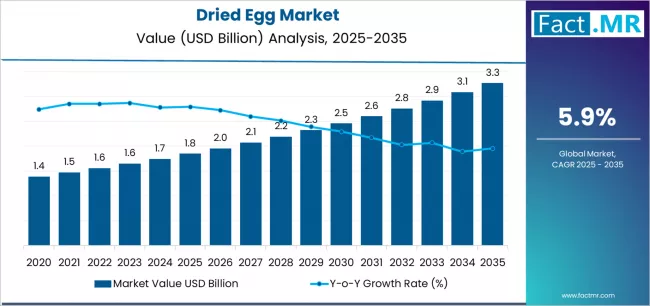
The steady market expansion reflects the growing importance of dried egg products in modern food manufacturing and commercial food preparation systems. Major food manufacturers worldwide are incorporating advanced dried egg formulations to enhance product shelf life and reduce storage complexity through standardized protein content, while breakthrough developments in spray drying technologies and powder processing systems are creating demand for specialized egg powder products that deliver consistent functional properties and nutritional value across diverse food preparation environments.
Manufacturing capabilities are advancing as leading food processing companies invest in automated egg breaking facilities and precision drying equipment to meet growing market demand for enhanced product consistency and reduced processing costs. The technology landscape continues evolving with innovations in encapsulation techniques, moisture control systems, and quality preservation methods that extend product shelf life while maintaining protein functionality. Food equipment manufacturers and processing specialists are collaborating to develop next-generation dried egg production systems that address specific application requirements across commercial bakeries, processed food manufacturing, and institutional food service operations.
Quality standards are becoming increasingly stringent as applications demand higher protein specifications and greater microbiological safety under extended storage conditions including temperature variations, humidity exposure, and extended distribution cycles. Industry certification programs and validation protocols ensure consistent product performance while supporting market confidence in dried egg technology adoption across critical food manufacturing systems and regulated food service environments. Regulatory compliance requirements for food safety and nutritional labeling applications are driving investments in comprehensive quality management systems and testing protocols throughout the food processing supply chain.
International collaboration is accelerating market development as major food manufacturing projects require coordinated efforts between multiple ingredient suppliers and food processing companies. Global food corporations are establishing standardized specifications for dried egg performance that influence worldwide manufacturing standards and create opportunities for specialized ingredient suppliers. Food engineering firms are forming strategic partnerships with egg processing companies to create application-specific solutions tailored to emerging food formulation requirements and commercial food preparation needs.
Investment patterns are shifting toward integrated solution development as major food manufacturers seek comprehensive dried egg systems that combine functional protein capabilities with enhanced nutritional profiles and cost-effective processing characteristics. Food companies are forming joint ventures with egg processors to develop customized ingredient platforms, while food manufacturers are acquiring stakes in specialized egg processing facilities to ensure access to consistent protein ingredients for their production and development programs. This trend toward strategic partnerships and supply chain integration is reshaping competitive dynamics across the food ingredient value chain.
Market maturation is evident in the emergence of specialized application segments that demand unique dried egg characteristics and performance specifications. Commercial bakery applications require extremely stable protein performance and consistent moisture levels under high-volume production requirements, while processed food systems need dried egg solutions that maintain functionality and nutritional value when handling complex formulation scenarios and automated manufacturing processes. These specialized requirements are driving innovation in processing technologies, packaging systems, and preservation methodologies that extend beyond traditional egg powder and food ingredient applications.
Dried Egg Market Key Takeaways
| Metric | Value |
|---|---|
| Market Value (2025) | USD 1,847.2 million |
| Market Forecast Value (2035) | USD 3,264.8 million |
| Forecast CAGR (2025-2035) | 5.9% |
Why is the Dried Egg Market Growing?
| FOOD PROCESSING EXPANSION | CONVENIENCE FOOD DEMAND | COMMERCIAL APPLICATIONS |
|---|---|---|
| Industrial Food Manufacturing - Large-scale food production facilities implementing dried egg ingredients for consistent protein content, extended shelf life, and reduced storage requirements across processed food manufacturing, commercial baking operations, and packaged food production with enhanced operational efficiency and standardized nutritional profiles. | Ready-to-Eat Products - Consumer demand for convenient meal solutions requiring shelf-stable protein ingredients implementing dried egg formulations for instant meals, protein bars, and packaged breakfast products with extended storage capability and consistent nutritional value throughout distribution cycles. | Commercial Bakery Operations - Professional bakery facilities utilizing dried egg products for large-scale bread production, pastry manufacturing, and commercial baking applications requiring consistent functional properties, reduced waste, and simplified inventory management with reliable protein performance. |
| Protein Ingredient Standards - Food manufacturing quality requirements implementing specialized dried egg formulations for nutritional enhancement, functional protein delivery, and ingredient standardization applications with superior consistency under automated production conditions and regulatory compliance protocols. | Emergency Food Supplies - Disaster preparedness and long-term food storage markets implementing dried egg products for emergency rations, military food systems, and survival food packages requiring extended shelf life, compact storage, and maintained nutritional value without refrigeration requirements. | Food Service Industry - Restaurant chains, catering operations, and institutional food service implementing dried egg ingredients for menu standardization, cost control, and operational efficiency with consistent preparation results and reduced food safety risks across multiple preparation locations. |
| Export Market Development - International food trade expansion requiring shelf-stable egg products for global distribution, export food manufacturing, and international ingredient supply with reduced transportation costs and simplified logistics management across extended supply chains. | Health-Conscious Consumers - Growing nutrition awareness driving adoption of protein-rich dried egg products for dietary supplementation, fitness nutrition, and specialized dietary programs requiring concentrated protein sources with extended storage capability and preparation convenience. | Institutional Catering - School meal programs, hospital food service, and corporate catering implementing dried egg solutions for large-volume food preparation, nutritional compliance, and cost-effective protein delivery with consistent quality standards and operational simplicity. |
Dried Egg Market Segmentation
Category Segments Covered
| Category | Segments / Values |
|---|---|
| By Type | Whole Egg Powder; Egg White Powder; Egg Yolk Powder; Egg Albumen; Others |
| By Application | Food Processing; Bakery Products; Confectionery; Mayonnaise & Sauces; Others |
| By End-User | Food Manufacturers; Commercial Bakeries; Restaurant Chains; Institutional Catering; Others |
| By Form | Spray Dried; Freeze Dried; Pan Dried; Flake Form; Others |
| By Distribution Channel | Direct Sales; Distributors; Online Platforms; Specialty Food Suppliers |
| By Region | North America; Europe; Asia Pacific; Latin America; Middle East & Africa |
Dried Egg Market Analysis by Type
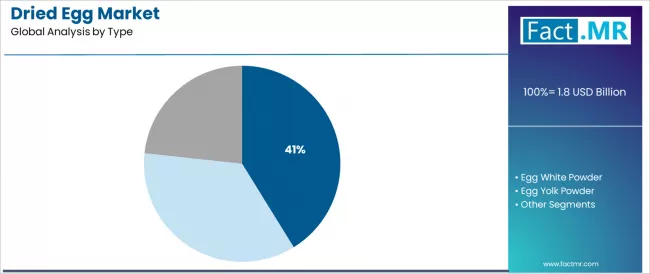
| Segment | 2025-2035 Outlook |
|---|---|
| Whole Egg Powder | Leader in 2025 with 41.0% market share; comprehensive nutritional profile and versatile application compatibility for food processing and commercial bakery operations. Widely adopted for processed food manufacturing and institutional food service requiring complete egg functionality. Momentum: exceptional growth across commercial food processing and bakery applications. Watchouts: higher production costs and complex processing requirements compared to specialized egg fractions. |
| Egg White Powder | Significant segment with 28.7% share, favored for protein-focused applications and specialized food formulations requiring fat-free protein content and enhanced whipping properties across fitness nutrition and commercial baking sectors. Momentum: strong growth in health-conscious food manufacturing and protein supplement applications. Watchouts: limited functional versatility compared to whole egg products in certain food applications. |
| Egg Yolk Powder | Specialized segment offering concentrated flavor enhancement and emulsification properties for premium food manufacturing and sauce production applications requiring superior taste profiles. Momentum: growing adoption in gourmet food processing and specialty sauce manufacturing. Watchouts: higher cost structure and specialized handling requirements. |
| Others | Includes egg albumen and specialized egg fractions for technical food applications. Momentum: selective growth in specialized food manufacturing and technical applications. |
Dried Egg Market Analysis by Application
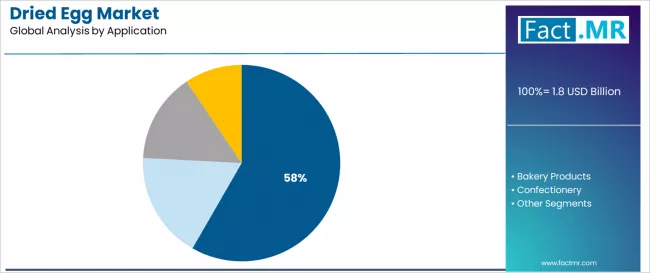
| Segment | 2025-2035 Outlook |
|---|---|
| Food Processing | Largest application segment in 2025 at 58.3% share, driven by industrial food manufacturing demand for standardized protein ingredients and consistent functional properties across processed food production, snack manufacturing, and packaged meal preparation systems. Includes pasta manufacturing, instant food production, and processed meat applications. Momentum: robust growth from convenience food expansion and automated food processing technology adoption. Watchouts: price sensitivity and ingredient cost pressures in competitive processed food markets. |
| Bakery Products | Critical segment representing 23.9% share, experiencing strong growth from commercial bakery operations and artisan bread production implementing dried egg ingredients for improved texture, extended shelf life, and consistent baking performance. Momentum: exceptional growth as bakery operators adopt standardized ingredient systems for quality control and operational efficiency. Watchouts: competition from fresh egg suppliers and specialized bakery ingredient alternatives. |
| Confectionery | Growing segment at 11.6% share for chocolate manufacturing, candy production, and specialty confection applications requiring precise moisture control and enhanced flavor profiles with extended storage capability. Momentum: strong growth from premium confectionery market expansion and artisanal candy manufacturing trends. Watchouts: specialized quality requirements and seasonal demand variations. |
| Others | Includes mayonnaise production, sauce manufacturing, and specialized food applications. Momentum: diverse growth opportunities across multiple food processing sectors. |
Dried Egg Market Analysis by Distribution Channel
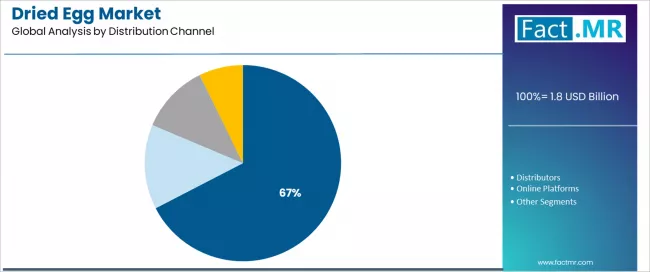
| Distribution Channel | Status & Outlook (2025-2035) |
|---|---|
| Direct Sales | Dominant channel in 2025 with 67.4% share for large-scale food manufacturer applications. Provides bulk ingredient supply, technical support, and customized product specifications for commercial food processing operations. Momentum: strong growth driven by food manufacturer consolidation and ingredient supply chain optimization. Watchouts: limited market reach for smaller food processing operations and specialized applications. |
| Distributors | Technical distribution serving regional food processors and commercial bakeries with comprehensive ingredient portfolios and local market expertise. Momentum: moderate growth as market expands beyond large-scale industrial applications. Watchouts: margin pressure and competition from direct supplier relationships. |
| Online Platforms | Digital channel for specialty food manufacturers and small-scale food processors seeking convenient procurement and competitive pricing for dried egg ingredients. Momentum: growing importance as smaller food businesses seek accessible ingredient sourcing. |
| Specialty Food Suppliers | Focused channel for premium dried egg products and specialized applications serving artisanal food manufacturers and gourmet food processors. Momentum: strategic growth as specialty food markets expand and quality requirements increase. |
DRIVERS
| DRIVERS | RESTRAINTS | KEY TRENDS |
|---|---|---|
| Food Industry Growth across processed food manufacturing and commercial food preparation creating substantial demand for standardized egg ingredients supporting consistent protein delivery, reduced storage requirements, and simplified inventory management for large-scale food production operations and commercial kitchen facilities. | Fresh Egg Competition and consumer preferences for natural ingredients limit adoption across certain food applications and consumer-facing products with traditional preparation methods and premium positioning strategies. | Clean Label Movement - Food manufacturers implementing natural processing methods, minimal ingredient lists, and transparent labeling requirements for dried egg products meeting consumer demands for recognizable ingredients and simplified food formulations without artificial additives. |
| Shelf Life Requirements - Global food distribution networks and extended supply chains driving adoption of dried egg products for international food trade, emergency food supplies, and long-term storage applications requiring consistent nutritional value and microbiological safety. | Processing Cost Structure - Complex drying technologies, specialized equipment requirements, and quality control procedures affect production economics and pricing competitiveness compared to fresh egg alternatives in certain market segments and price-sensitive applications. | Protein Fortification - Growing nutrition awareness and dietary protein requirements driving integration of dried egg ingredients into protein bars, nutritional supplements, and functional food products delivering concentrated protein content and essential amino acid profiles. |
| Food Safety Standards - Enhanced microbiological safety requirements and pathogen reduction protocols across commercial food preparation driving adoption of processed egg ingredients for reduced contamination risk, consistent quality assurance, and regulatory compliance in food service operations. | Supply Chain Complexity - Egg production volatility, seasonal availability variations, and agricultural commodity price fluctuations create sourcing challenges and cost uncertainty for dried egg processors and food manufacturing customers. | Automation Integration - Advanced food processing equipment and automated production systems requiring standardized ingredient specifications and consistent flow properties driving demand for engineered dried egg formulations optimized for mechanical handling and processing efficiency. |
| Convenience Food Markets - Consumer lifestyle changes and meal preparation trends creating demand for instant food products, ready-to-cook meals, and convenience food solutions implementing dried egg ingredients for extended shelf life and preparation simplicity. | Regulatory Requirements - Food labeling regulations, nutritional disclosure standards, and allergen identification requirements create compliance complexity and documentation burdens for dried egg suppliers and food manufacturing customers. | Specialty Applications - Expanding use in gluten-free baking, vegan food alternatives, and specialized dietary products requiring functional egg properties through innovative processing methods and application-specific formulations meeting diverse consumer needs. |
Analysis of Dried Egg Market by Key Countries
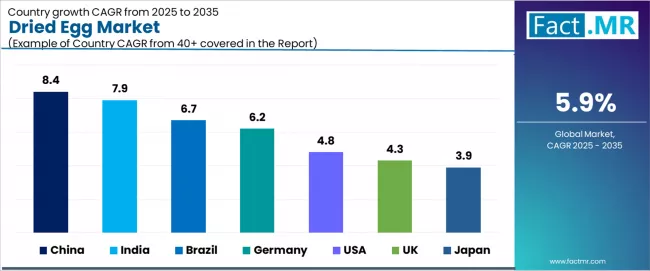
| Country | CAGR (2025-2035) |
|---|---|
| China | 8.4% |
| India | 7.9% |
| Germany | 6.2% |
| Brazil | 6.7% |
| USA | 4.8% |
| UK | 4.3% |
| Japan | 3.9% |
China Leads Global Market Growth with Manufacturing Excellence
Revenue from Dried Egg in China is projected to exhibit exceptional growth with a market value of USD 892.6 million by 2035, driven by massive food processing industry expansion and comprehensive convenience food development initiatives creating substantial opportunities for dried egg suppliers across processed food manufacturing, commercial bakery systems, and institutional food service sectors. The country's ambitious food safety modernization programs including national food processing facility upgrades and automated food production system expansion are creating unprecedented demand for standardized egg ingredients. Major food manufacturers and processing companies including Cofco Corporation, Want Want Holdings, and Tingyi are establishing comprehensive dried egg procurement programs to support large-scale food production and advanced processing applications.
- National food processing modernization programs and commercial food facility development projects are supporting widespread adoption of standardized egg ingredients across processed food systems, driving demand for consistent protein components
- Food safety enhancement initiatives and quality control system programs are creating substantial opportunities for suppliers requiring reliable performance and certified egg ingredients for large-scale food manufacturing applications
- Commercial food production expansion and processing facility upgrades are facilitating adoption of specialized dried egg systems throughout major food manufacturing regions
India Demonstrates Strong Market Potential with Infrastructure Growth
Revenue from Dried Egg in India is expanding to reach USD 476.3 million by 2035, supported by extensive food processing industry development programs and comprehensive commercial food service modernization initiatives creating demand for dried egg solutions across diverse processed food and institutional catering application segments. The country's growing food manufacturing capabilities and expanding commercial kitchen infrastructure are driving demand for egg ingredients that provide exceptional shelf stability while supporting diverse food preparation requirements. Food companies and processing facilities are investing in dried egg procurement to support growing food service demand and commercial food production advancement requirements.
- Food processing industry expansion and commercial kitchen development are creating opportunities for dried egg ingredients across diverse application segments requiring exceptional stability and competitive performance specifications
- Infrastructure development programs and food service modernization are driving investments in standardized ingredient systems supporting food safety requirements throughout major metropolitan regions
- Manufacturing facility growth and specialized food processing development programs are enhancing demand for quality dried egg solutions throughout Indian food markets
Germany Maintains Leadership with Engineering Excellence
Demand for Dried Egg in Germany is projected to reach USD 348.7 million by 2035, supported by the country's leadership in food processing technology and advanced manufacturing systems requiring sophisticated dried egg solutions for premium food production and commercial food processing applications. German food operators are implementing cutting-edge ingredient systems that support advanced quality control capabilities, operational precision, and comprehensive performance monitoring protocols. The market is characterized by focus on processing excellence, food safety innovation, and compliance with stringent food quality and safety standards.
- Food processing industry investments and manufacturing technology leadership are prioritizing advanced dried egg ingredients that demonstrate superior functional performance and stability while meeting German food safety and quality standards
- Premium food manufacturing leadership programs and technology innovation initiatives are driving adoption of precision-engineered egg ingredients that support advanced food processing infrastructure and production optimization
- Food system engineering programs for manufacturing enhancement are facilitating adoption of specialized dried egg technologies throughout major food processing and commercial food preparation centers
Brazil Expands Market with Infrastructure Development
Revenue from Dried Egg in Brazil is growing to reach USD 267.4 million by 2035, driven by food processing infrastructure development programs and increasing commercial food manufacturing capabilities creating opportunities for dried egg suppliers serving both food processors and specialized ingredient contractors. The country's expanding food industry sector and growing commercial food service infrastructure are creating demand for egg ingredients that support diverse food processing requirements while maintaining performance standards. Food companies and manufacturing facilities are developing ingredient strategies to support operational efficiency and product quality advancement.
- Food processing infrastructure development programs and manufacturing modernization are facilitating adoption of dried egg ingredients capable of supporting diverse food processing requirements and competitive performance standards
- Commercial food manufacturing expansion and food-focused development programs are enhancing demand for quality egg ingredients that support operational efficiency and food system reliability
- Ingredient market expansion and specialized food processing development are creating opportunities for advanced dried egg capabilities across Brazilian food manufacturing and processing facilities
USA Focuses on Technology Innovation and Premium Applications
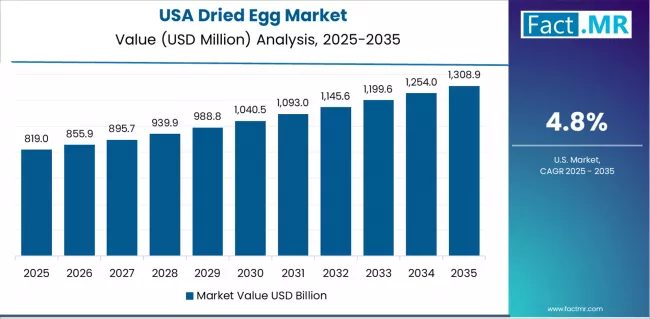
Demand for Dried Egg in USA is projected to reach USD 234.1 million by 2035, expanding at a CAGR of 4.8%, driven by advanced food processing technology innovation and specialized premium food applications supporting commercial bakery manufacturing and comprehensive food processing applications. The country's established food manufacturing tradition including major food processors and commercial bakery facilities are creating demand for high-performance dried egg ingredients that support operational advancement and food safety standards. Manufacturers and food system suppliers are maintaining comprehensive development capabilities to support diverse food processing and ingredient requirements.
- Advanced food processing technology innovation including major food manufacturers and specialized commercial food programs are supporting demand for quality dried egg systems that meet contemporary performance and safety standards
- Premium food manufacturing advancement and commercial food processing programs are creating opportunities for specialized egg ingredients that provide comprehensive food quality support
- Food processing excellence and ingredient quality enhancement programs are facilitating adoption of advanced dried egg capabilities throughout major food manufacturing and processing regions
UK Emphasizes Food Heritage
Revenue from Dried Egg in UK is growing to reach USD 198.5 million by 2035, supported by food manufacturing heritage and established commercial food communities driving demand for premium dried egg solutions across traditional food processing systems and specialized commercial food applications. The country's rich food processing heritage including major food manufacturers and established commercial food capabilities create demand for egg ingredients that support both traditional food preparation advancement and modern commercial applications.
- Food manufacturing heritage preservation and advanced commercial food programs are supporting demand for specialized dried egg systems that meet historical excellence and contemporary performance standards
- Commercial food collaboration and international partnership development are creating opportunities for dried egg ingredients throughout British food processing facilities
- Food technology modernization and infrastructure advancement programs are facilitating adoption of advanced dried egg technologies across traditional food markets
Japan Maintains Precision with Technology Leadership
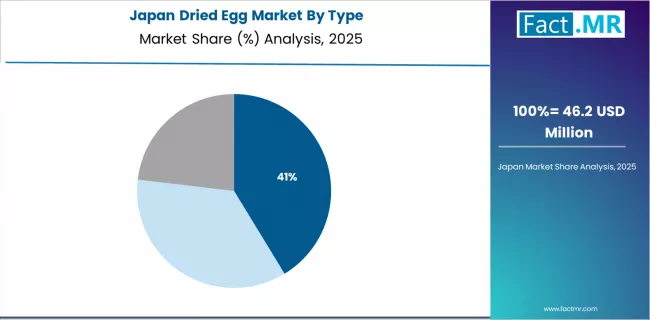
Demand for Dried Egg in Japan is projected to reach USD 187.9 million by 2035, driven by precision food processing tradition and established manufacturing leadership supporting both domestic food system markets and export-oriented ingredient production. Japanese companies maintain sophisticated dried egg development capabilities, with established manufacturers continuing to lead in food ingredient technology and processing equipment standards.
- Precision food processing tradition and manufacturing leadership including major food equipment manufacturers are supporting continued demand for high-performance ingredients that meet exacting quality standards
- Advanced food system research and traditional manufacturing excellence are creating opportunities for premium dried egg ingredients throughout Japanese food markets
- Export manufacturing excellence and ingredient quality programs are facilitating adoption of advanced dried egg production capabilities across specialized food processing facilities
Europe Market Split by Application Focus
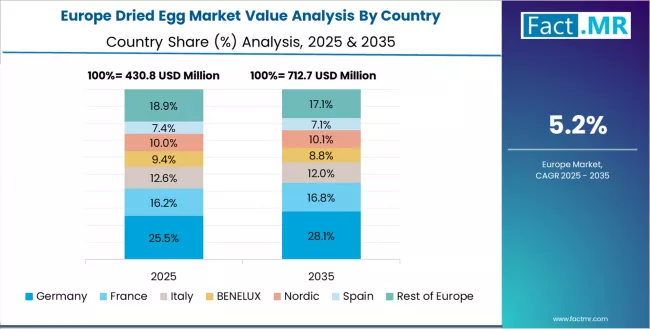
European Dried Egg operations are increasingly concentrated between German processing excellence and specialized manufacturing across multiple countries. German facilities dominate high-performance dried egg production for premium food processing and commercial bakery applications, leveraging cutting-edge processing technologies and strict quality protocols that command price premiums in global markets. British food processing operators maintain leadership in ingredient innovation and dried egg method development, with organizations like Premier Foods and university research centers driving technical specifications that suppliers must meet to access major food manufacturing contracts.
Eastern European operations in Poland and Czech Republic are capturing specialized production contracts through precision processing expertise and EU compliance standards, particularly in egg powder manufacturing and commercial food ingredient technologies. These facilities increasingly serve as development partners for Western European food programs while building their own food processing expertise.
The regulatory environment presents both opportunities and constraints. European food safety framework requirements create quality standards that favor established European manufacturers and food processing operators while ensuring consistent performance specifications for critical food manufacturing infrastructure and safety applications. Brexit has created complexity for UK food industry collaboration with EU programs, driving opportunities for direct relationships between British operators and international dried egg suppliers.
Food technology collaboration accelerates as food manufacturers seek ingredient advancement to support major food safety milestones and automated processing development timelines. Vertical integration increases, with major food processing operators acquiring specialized ingredient capabilities to secure component supplies and quality control for critical food programs. Smaller food contractors face pressure to specialize in niche applications or risk displacement by larger, more comprehensive operations serving mainstream food processing and commercial requirements.
Market Dynamics Drive Innovation in South Korea
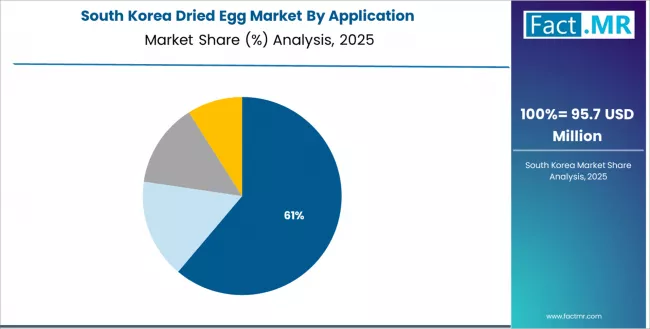
South Korean Dried Egg operations reflect the country's advanced food processing capabilities and export-oriented commercial food development model. Major food system operators including CJ CheilJedang and food technology companies drive ingredient procurement strategies for their processing facilities, establishing direct relationships with specialized dried egg suppliers to secure consistent quality and performance for their food development programs and advanced commercial food systems targeting both domestic infrastructure and international collaboration projects.
The Korean market demonstrates particular strength in integrating dried egg ingredients into processed food platforms and advanced commercial food system configurations, with engineering teams developing solutions that bridge traditional food processing applications and next-generation automated food systems. This integration approach creates demand for specific performance specifications that differ from conventional applications, requiring suppliers to adapt ingredient capabilities and processing coordination characteristics.
Regulatory frameworks emphasize food safety and processing system reliability, with Korean food standards often exceeding international requirements for dried egg systems. This creates barriers for standard ingredient suppliers but benefits established manufacturers who can demonstrate food-grade performance capabilities. The regulatory environment particularly favors suppliers with Korean food system qualification and comprehensive testing documentation systems.
Supply chain excellence remains critical given Korea's food processing focus and international collaboration dynamics. Food system operators increasingly pursue development partnerships with suppliers in China, Japan, and specialized manufacturers to ensure access to cutting-edge dried egg technologies while managing infrastructure risks. Investment in food processing infrastructure supports performance advancement during extended food development cycles.
Competitive Landscape of Dried Egg Market
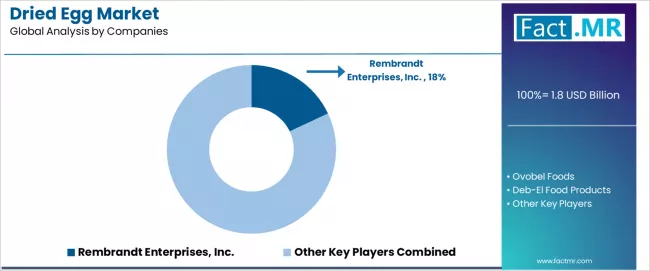
Profit pools are consolidating upstream in advanced egg processing manufacturing and downstream in application-specific solutions for food processing integration, commercial bakery applications, and institutional food service markets where functional performance, processing reliability, and consistent nutritional profiles command substantial premiums. Value is migrating from basic egg powder production to specification-driven, food-grade dried egg systems where processing expertise, quality control manufacturing, and reliable ingredient capabilities create competitive advantages.
Several archetypes define market leadership: established American food ingredient companies defending share through advanced processing platform development and comprehensive food industry integration support; European food processors leveraging manufacturing excellence and commercial food system capabilities; specialized egg processing leaders with food industry expertise and precision manufacturing heritage; and emerging ingredient manufacturers pursuing cost-effective production while developing advanced processing capabilities.
Switching costs - ingredient specification, food system compatibility validation, food safety certification - provide stability for established suppliers, while technological advancement requirements and premium food application growth create opportunities for innovative ingredient manufacturers. Consolidation continues as companies seek processing scale; direct food manufacturer partnerships grow for specialized applications while traditional food ingredient distribution remains relationship-driven.
Focus areas: secure premium food processing and commercial food service market positions with application-specific performance specifications and technical collaboration; develop dried egg technology and advanced processing capabilities; explore specialized applications including convenience food and institutional catering infrastructure requirements.
| Stakeholder Type | Primary Advantage | Repeatable Plays |
|---|---|---|
| American Food Ingredient Leaders | Advanced processing platform expertise; proven food industry integration; established manufacturer relationships | Precision processing; technical innovation; food safety certification support |
| European Food Processors | Manufacturing excellence; comprehensive food development programs; established customer partnerships | Engineering collaboration focus; integrated solutions; technical consultation |
| Specialized Egg Processing Leaders | Food ingredient expertise; precision processing leadership; trusted by major food programs | Food manufacturer partnerships; application-specific specifications; food infrastructure collaboration |
| Emerging Ingredient Producers | Processing efficiency; competitive pricing; rapid technology development | Production scaling; technology advancement; market entry strategies |
| Food Ingredient Distributors | Technical distribution networks; food industry relationships | Food processing expertise; inventory management; technical support services |
Key Players in the Dried Egg Market
- Rembrandt Enterprises, Inc.
- Ovobel Foods
- Deb-El Food Products
- Sanovo Technology Group
- Igreca (Groupe Soufflet)
- SKM Egg Products
- Avril Group
- Rose Acre Farms, Inc.
- Cal-Maine Foods, Inc.
- Midwest Poultry Services
- Daybreak Foods, Inc.
- Bouwhuis Enthoven
- Eurovo Group
- Noble Foods Ltd.
- Lactalis Ingredients
- Kewpie Corporation
- Prima Meat Packers
- Q&C Co., Ltd.
Scope of the Report
| Item | Value |
|---|---|
| Quantitative Units | USD 1,847.2 Million |
| Type Segments | Whole Egg Powder; Egg White Powder; Egg Yolk Powder; Egg Albumen; Others |
| Applications | Food Processing; Bakery Products; Confectionery; Mayonnaise & Sauces; Others |
| End-Users | Food Manufacturers; Commercial Bakeries; Restaurant Chains; Institutional Catering; Others |
| Form Segments | Spray Dried; Freeze Dried; Pan Dried; Flake Form; Others |
| Distribution Channels | Direct Sales; Distributors; Online Platforms; Specialty Food Suppliers |
| Regions Covered | North America; Latin America; Europe; Asia Pacific; Middle East & Africa |
| Key Countries | China; India; Germany; Brazil; USA; UK; Japan (+35 additional countries) |
| Key Companies Profiled | Rembrandt Enterprises; Ovobel Foods; Deb-El Food Products; Sanovo Technology Group; Igreca (Groupe Soufflet); SKM Egg Products; Avril Group; Rose Acre Farms; Cal-Maine Foods; Midwest Poultry Services; Daybreak Foods; Bouwhuis Enthoven; Eurovo Group; Noble Foods; Lactalis Ingredients; Kewpie Corporation; Prima Meat Packers; Q&C Co., Ltd |
| Additional Attributes | Dollar sales by type and application; Regional demand trends (NA, EU, APAC); Competitive landscape; Food processing vs. commercial bakery adoption patterns; Food manufacturing and ingredient integration; Advanced processing innovations driving quality enhancement, shelf life extension, and food safety excellence |
Dried Egg Market Segmentation
-
By Type :
- Whole Egg Powder
- Egg White Powder
- Egg Yolk Powder
- Egg Albumen
- Others
-
By Application :
- Food Processing
- Bakery Products
- Confectionery
- Mayonnaise & Sauces
- Others
-
By End-User :
- Food Manufacturers
- Commercial Bakeries
- Restaurant Chains
- Institutional Catering
- Others
-
By Form :
- Spray Dried
- Freeze Dried
- Pan Dried
- Flake Form
- Others
-
By Distribution Channel :
- Direct Sales
- Distributors
- Online Platforms
- Specialty Food Suppliers
-
By Region :
- North America
- USA
- Canada
- Mexico
- Latin America
- Brazil
- Chile
- Rest of Latin America
- Western Europe
- Germany
- UK
- France
- Italy
- Spain
- Nordic
- BENELUX
- Rest of Western Europe
- Eastern Europe
- Russia
- Poland
- Rest of Eastern Europe
- East Asia
- China
- Japan
- South Korea
- South Asia Pacific
- India
- ASEAN
- Australia & New Zealand
- Rest of South Asia Pacific
- Middle East & Africa
- Kingdom of Saudi Arabia
- Other GCC Countries
- Turkey
- South Africa
- Other African Union
- Rest of Middle East & Africa
- North America
Table of Content
- Executive Summary
- Global Market Outlook
- Demand to side Trends
- Supply to side Trends
- Technology Roadmap Analysis
- Analysis and Recommendations
- Market Overview
- Market Coverage / Taxonomy
- Market Definition / Scope / Limitations
- Market Background
- Market Dynamics
- Drivers
- Restraints
- Opportunity
- Trends
- Scenario Forecast
- Demand in Optimistic Scenario
- Demand in Likely Scenario
- Demand in Conservative Scenario
- Opportunity Map Analysis
- Product Life Cycle Analysis
- Supply Chain Analysis
- Investment Feasibility Matrix
- Value Chain Analysis
- PESTLE and Porter’s Analysis
- Regulatory Landscape
- Regional Parent Market Outlook
- Production and Consumption Statistics
- Import and Export Statistics
- Market Dynamics
- Global Market Analysis 2020 to 2024 and Forecast, 2025 to 2035
- Historical Market Size Value (USD Million) Analysis, 2020 to 2024
- Current and Future Market Size Value (USD Million) Projections, 2025 to 2035
- Y to o to Y Growth Trend Analysis
- Absolute $ Opportunity Analysis
- Global Market Pricing Analysis 2020 to 2024 and Forecast 2025 to 2035
- Global Market Analysis 2020 to 2024 and Forecast 2025 to 2035, By Type
- Introduction / Key Findings
- Historical Market Size Value (USD Million) Analysis By Type , 2020 to 2024
- Current and Future Market Size Value (USD Million) Analysis and Forecast By Type , 2025 to 2035
- Whole Egg Powder
- Egg White Powder
- Egg Yolk Powder
- Y to o to Y Growth Trend Analysis By Type , 2020 to 2024
- Absolute $ Opportunity Analysis By Type , 2025 to 2035
- Global Market Analysis 2020 to 2024 and Forecast 2025 to 2035, By Application
- Introduction / Key Findings
- Historical Market Size Value (USD Million) Analysis By Application, 2020 to 2024
- Current and Future Market Size Value (USD Million) Analysis and Forecast By Application, 2025 to 2035
- Food Processing
- Bakery Products
- Confectionery
- Others
- Y to o to Y Growth Trend Analysis By Application, 2020 to 2024
- Absolute $ Opportunity Analysis By Application, 2025 to 2035
- Global Market Analysis 2020 to 2024 and Forecast 2025 to 2035, By Distribution Channel
- Introduction / Key Findings
- Historical Market Size Value (USD Million) Analysis By Distribution Channel, 2020 to 2024
- Current and Future Market Size Value (USD Million) Analysis and Forecast By Distribution Channel, 2025 to 2035
- Direct Sales
- Distributors
- Online Platforms
- Specialty Food Suppliers
- Y to o to Y Growth Trend Analysis By Distribution Channel, 2020 to 2024
- Absolute $ Opportunity Analysis By Distribution Channel, 2025 to 2035
- Global Market Analysis 2020 to 2024 and Forecast 2025 to 2035, By Region
- Introduction
- Historical Market Size Value (USD Million) Analysis By Region, 2020 to 2024
- Current Market Size Value (USD Million) Analysis and Forecast By Region, 2025 to 2035
- North America
- Latin America
- Western Europe
- Eastern Europe
- East Asia
- South Asia and Pacific
- Middle East & Africa
- Market Attractiveness Analysis By Region
- North America Market Analysis 2020 to 2024 and Forecast 2025 to 2035, By Country
- Historical Market Size Value (USD Million) Trend Analysis By Market Taxonomy, 2020 to 2024
- Market Size Value (USD Million) Forecast By Market Taxonomy, 2025 to 2035
- By Country
- USA
- Canada
- Mexico
- By Type
- By Application
- By Distribution Channel
- By Country
- Market Attractiveness Analysis
- By Country
- By Type
- By Application
- By Distribution Channel
- Key Takeaways
- Latin America Market Analysis 2020 to 2024 and Forecast 2025 to 2035, By Country
- Historical Market Size Value (USD Million) Trend Analysis By Market Taxonomy, 2020 to 2024
- Market Size Value (USD Million) Forecast By Market Taxonomy, 2025 to 2035
- By Country
- Brazil
- Chile
- Rest of Latin America
- By Type
- By Application
- By Distribution Channel
- By Country
- Market Attractiveness Analysis
- By Country
- By Type
- By Application
- By Distribution Channel
- Key Takeaways
- Western Europe Market Analysis 2020 to 2024 and Forecast 2025 to 2035, By Country
- Historical Market Size Value (USD Million) Trend Analysis By Market Taxonomy, 2020 to 2024
- Market Size Value (USD Million) Forecast By Market Taxonomy, 2025 to 2035
- By Country
- Germany
- UK
- Italy
- Spain
- France
- Nordic
- BENELUX
- Rest of Western Europe
- By Type
- By Application
- By Distribution Channel
- By Country
- Market Attractiveness Analysis
- By Country
- By Type
- By Application
- By Distribution Channel
- Key Takeaways
- Eastern Europe Market Analysis 2020 to 2024 and Forecast 2025 to 2035, By Country
- Historical Market Size Value (USD Million) Trend Analysis By Market Taxonomy, 2020 to 2024
- Market Size Value (USD Million) Forecast By Market Taxonomy, 2025 to 2035
- By Country
- Russia
- Poland
- Hungary
- Balkan & Baltic
- Rest of Eastern Europe
- By Type
- By Application
- By Distribution Channel
- By Country
- Market Attractiveness Analysis
- By Country
- By Type
- By Application
- By Distribution Channel
- Key Takeaways
- East Asia Market Analysis 2020 to 2024 and Forecast 2025 to 2035, By Country
- Historical Market Size Value (USD Million) Trend Analysis By Market Taxonomy, 2020 to 2024
- Market Size Value (USD Million) Forecast By Market Taxonomy, 2025 to 2035
- By Country
- China
- Japan
- South Korea
- By Type
- By Application
- By Distribution Channel
- By Country
- Market Attractiveness Analysis
- By Country
- By Type
- By Application
- By Distribution Channel
- Key Takeaways
- South Asia and Pacific Market Analysis 2020 to 2024 and Forecast 2025 to 2035, By Country
- Historical Market Size Value (USD Million) Trend Analysis By Market Taxonomy, 2020 to 2024
- Market Size Value (USD Million) Forecast By Market Taxonomy, 2025 to 2035
- By Country
- India
- ASEAN
- Australia & New Zealand
- Rest of South Asia and Pacific
- By Type
- By Application
- By Distribution Channel
- By Country
- Market Attractiveness Analysis
- By Country
- By Type
- By Application
- By Distribution Channel
- Key Takeaways
- Middle East & Africa Market Analysis 2020 to 2024 and Forecast 2025 to 2035, By Country
- Historical Market Size Value (USD Million) Trend Analysis By Market Taxonomy, 2020 to 2024
- Market Size Value (USD Million) Forecast By Market Taxonomy, 2025 to 2035
- By Country
- Kingdom of Saudi Arabia
- Other GCC Countries
- Turkiye
- South Africa
- Other African Union
- Rest of Middle East & Africa
- By Type
- By Application
- By Distribution Channel
- By Country
- Market Attractiveness Analysis
- By Country
- By Type
- By Application
- By Distribution Channel
- Key Takeaways
- Key Countries Market Analysis
- USA
- Pricing Analysis
- Market Share Analysis, 2024
- By Type
- By Application
- By Distribution Channel
- Canada
- Pricing Analysis
- Market Share Analysis, 2024
- By Type
- By Application
- By Distribution Channel
- Mexico
- Pricing Analysis
- Market Share Analysis, 2024
- By Type
- By Application
- By Distribution Channel
- Brazil
- Pricing Analysis
- Market Share Analysis, 2024
- By Type
- By Application
- By Distribution Channel
- Chile
- Pricing Analysis
- Market Share Analysis, 2024
- By Type
- By Application
- By Distribution Channel
- Germany
- Pricing Analysis
- Market Share Analysis, 2024
- By Type
- By Application
- By Distribution Channel
- UK
- Pricing Analysis
- Market Share Analysis, 2024
- By Type
- By Application
- By Distribution Channel
- Italy
- Pricing Analysis
- Market Share Analysis, 2024
- By Type
- By Application
- By Distribution Channel
- Spain
- Pricing Analysis
- Market Share Analysis, 2024
- By Type
- By Application
- By Distribution Channel
- France
- Pricing Analysis
- Market Share Analysis, 2024
- By Type
- By Application
- By Distribution Channel
- India
- Pricing Analysis
- Market Share Analysis, 2024
- By Type
- By Application
- By Distribution Channel
- ASEAN
- Pricing Analysis
- Market Share Analysis, 2024
- By Type
- By Application
- By Distribution Channel
- Australia & New Zealand
- Pricing Analysis
- Market Share Analysis, 2024
- By Type
- By Application
- By Distribution Channel
- China
- Pricing Analysis
- Market Share Analysis, 2024
- By Type
- By Application
- By Distribution Channel
- Japan
- Pricing Analysis
- Market Share Analysis, 2024
- By Type
- By Application
- By Distribution Channel
- South Korea
- Pricing Analysis
- Market Share Analysis, 2024
- By Type
- By Application
- By Distribution Channel
- Russia
- Pricing Analysis
- Market Share Analysis, 2024
- By Type
- By Application
- By Distribution Channel
- Poland
- Pricing Analysis
- Market Share Analysis, 2024
- By Type
- By Application
- By Distribution Channel
- Hungary
- Pricing Analysis
- Market Share Analysis, 2024
- By Type
- By Application
- By Distribution Channel
- Kingdom of Saudi Arabia
- Pricing Analysis
- Market Share Analysis, 2024
- By Type
- By Application
- By Distribution Channel
- Turkiye
- Pricing Analysis
- Market Share Analysis, 2024
- By Type
- By Application
- By Distribution Channel
- South Africa
- Pricing Analysis
- Market Share Analysis, 2024
- By Type
- By Application
- By Distribution Channel
- USA
- Market Structure Analysis
- Competition Dashboard
- Competition Benchmarking
- Market Share Analysis of Top Players
- By Regional
- By Type
- By Application
- By Distribution Channel
- Competition Analysis
- Competition Deep Dive
- Rembrandt Enterprises, Inc.
- Overview
- Product Portfolio
- Profitability by Market Segments (Product/Age /Sales Channel/Region)
- Sales Footprint
- Strategy Overview
- Marketing Strategy
- Product Strategy
- Channel Strategy
- Ovobel Foods
- Deb-El Food Products
- Sanovo Technology Group
- Igreca (Groupe Soufflet)
- SKM Egg Products
- Avril Group
- Rose Acre Farms, Inc.
- Cal-Maine Foods, Inc.
- Midwest Poultry Services
- Daybreak Foods, Inc.
- Bouwhuis Enthoven
- Eurovo Group
- Noble Foods Ltd.
- Lactalis Ingredients
- Kewpie Corporation
- Prima Meat Packers
- Q&C Co., Ltd.
- Rembrandt Enterprises, Inc.
- Competition Deep Dive
- Assumptions & Acronyms Used
- Research Methodology
List Of Table
- Table 1: Global Market Value (USD Million) Forecast by Region, 2020 to 2035
- Table 2: Global Market Value (USD Million) Forecast by Type , 2020 to 2035
- Table 3: Global Market Value (USD Million) Forecast by Application, 2020 to 2035
- Table 4: Global Market Value (USD Million) Forecast by Distribution Channel, 2020 to 2035
- Table 5: North America Market Value (USD Million) Forecast by Country, 2020 to 2035
- Table 6: North America Market Value (USD Million) Forecast by Type , 2020 to 2035
- Table 7: North America Market Value (USD Million) Forecast by Application, 2020 to 2035
- Table 8: North America Market Value (USD Million) Forecast by Distribution Channel, 2020 to 2035
- Table 9: Latin America Market Value (USD Million) Forecast by Country, 2020 to 2035
- Table 10: Latin America Market Value (USD Million) Forecast by Type , 2020 to 2035
- Table 11: Latin America Market Value (USD Million) Forecast by Application, 2020 to 2035
- Table 12: Latin America Market Value (USD Million) Forecast by Distribution Channel, 2020 to 2035
- Table 13: Western Europe Market Value (USD Million) Forecast by Country, 2020 to 2035
- Table 14: Western Europe Market Value (USD Million) Forecast by Type , 2020 to 2035
- Table 15: Western Europe Market Value (USD Million) Forecast by Application, 2020 to 2035
- Table 16: Western Europe Market Value (USD Million) Forecast by Distribution Channel, 2020 to 2035
- Table 17: Eastern Europe Market Value (USD Million) Forecast by Country, 2020 to 2035
- Table 18: Eastern Europe Market Value (USD Million) Forecast by Type , 2020 to 2035
- Table 19: Eastern Europe Market Value (USD Million) Forecast by Application, 2020 to 2035
- Table 20: Eastern Europe Market Value (USD Million) Forecast by Distribution Channel, 2020 to 2035
- Table 21: East Asia Market Value (USD Million) Forecast by Country, 2020 to 2035
- Table 22: East Asia Market Value (USD Million) Forecast by Type , 2020 to 2035
- Table 23: East Asia Market Value (USD Million) Forecast by Application, 2020 to 2035
- Table 24: East Asia Market Value (USD Million) Forecast by Distribution Channel, 2020 to 2035
- Table 25: South Asia and Pacific Market Value (USD Million) Forecast by Country, 2020 to 2035
- Table 26: South Asia and Pacific Market Value (USD Million) Forecast by Type , 2020 to 2035
- Table 27: South Asia and Pacific Market Value (USD Million) Forecast by Application, 2020 to 2035
- Table 28: South Asia and Pacific Market Value (USD Million) Forecast by Distribution Channel, 2020 to 2035
- Table 29: Middle East & Africa Market Value (USD Million) Forecast by Country, 2020 to 2035
- Table 30: Middle East & Africa Market Value (USD Million) Forecast by Type , 2020 to 2035
- Table 31: Middle East & Africa Market Value (USD Million) Forecast by Application, 2020 to 2035
- Table 32: Middle East & Africa Market Value (USD Million) Forecast by Distribution Channel, 2020 to 2035
List Of Figures
- Figure 1: Global Market Pricing Analysis
- Figure 2: Global Market Value (USD Million) Forecast 2020-2035
- Figure 3: Global Market Value Share and BPS Analysis by Type , 2025 and 2035
- Figure 4: Global Market Y to o to Y Growth Comparison by Type , 2025-2035
- Figure 5: Global Market Attractiveness Analysis by Type
- Figure 6: Global Market Value Share and BPS Analysis by Application, 2025 and 2035
- Figure 7: Global Market Y to o to Y Growth Comparison by Application, 2025-2035
- Figure 8: Global Market Attractiveness Analysis by Application
- Figure 9: Global Market Value Share and BPS Analysis by Distribution Channel, 2025 and 2035
- Figure 10: Global Market Y to o to Y Growth Comparison by Distribution Channel, 2025-2035
- Figure 11: Global Market Attractiveness Analysis by Distribution Channel
- Figure 12: Global Market Value (USD Million) Share and BPS Analysis by Region, 2025 and 2035
- Figure 13: Global Market Y to o to Y Growth Comparison by Region, 2025-2035
- Figure 14: Global Market Attractiveness Analysis by Region
- Figure 15: North America Market Incremental Dollar Opportunity, 2025-2035
- Figure 16: Latin America Market Incremental Dollar Opportunity, 2025-2035
- Figure 17: Western Europe Market Incremental Dollar Opportunity, 2025-2035
- Figure 18: Eastern Europe Market Incremental Dollar Opportunity, 2025-2035
- Figure 19: East Asia Market Incremental Dollar Opportunity, 2025-2035
- Figure 20: South Asia and Pacific Market Incremental Dollar Opportunity, 2025-2035
- Figure 21: Middle East & Africa Market Incremental Dollar Opportunity, 2025-2035
- Figure 22: North America Market Value Share and BPS Analysis by Country, 2025 and 2035
- Figure 23: North America Market Value Share and BPS Analysis by Type , 2025 and 2035
- Figure 24: North America Market Y to o to Y Growth Comparison by Type , 2025-2035
- Figure 25: North America Market Attractiveness Analysis by Type
- Figure 26: North America Market Value Share and BPS Analysis by Application, 2025 and 2035
- Figure 27: North America Market Y to o to Y Growth Comparison by Application, 2025-2035
- Figure 28: North America Market Attractiveness Analysis by Application
- Figure 29: North America Market Value Share and BPS Analysis by Distribution Channel, 2025 and 2035
- Figure 30: North America Market Y to o to Y Growth Comparison by Distribution Channel, 2025-2035
- Figure 31: North America Market Attractiveness Analysis by Distribution Channel
- Figure 32: Latin America Market Value Share and BPS Analysis by Country, 2025 and 2035
- Figure 33: Latin America Market Value Share and BPS Analysis by Type , 2025 and 2035
- Figure 34: Latin America Market Y to o to Y Growth Comparison by Type , 2025-2035
- Figure 35: Latin America Market Attractiveness Analysis by Type
- Figure 36: Latin America Market Value Share and BPS Analysis by Application, 2025 and 2035
- Figure 37: Latin America Market Y to o to Y Growth Comparison by Application, 2025-2035
- Figure 38: Latin America Market Attractiveness Analysis by Application
- Figure 39: Latin America Market Value Share and BPS Analysis by Distribution Channel, 2025 and 2035
- Figure 40: Latin America Market Y to o to Y Growth Comparison by Distribution Channel, 2025-2035
- Figure 41: Latin America Market Attractiveness Analysis by Distribution Channel
- Figure 42: Western Europe Market Value Share and BPS Analysis by Country, 2025 and 2035
- Figure 43: Western Europe Market Value Share and BPS Analysis by Type , 2025 and 2035
- Figure 44: Western Europe Market Y to o to Y Growth Comparison by Type , 2025-2035
- Figure 45: Western Europe Market Attractiveness Analysis by Type
- Figure 46: Western Europe Market Value Share and BPS Analysis by Application, 2025 and 2035
- Figure 47: Western Europe Market Y to o to Y Growth Comparison by Application, 2025-2035
- Figure 48: Western Europe Market Attractiveness Analysis by Application
- Figure 49: Western Europe Market Value Share and BPS Analysis by Distribution Channel, 2025 and 2035
- Figure 50: Western Europe Market Y to o to Y Growth Comparison by Distribution Channel, 2025-2035
- Figure 51: Western Europe Market Attractiveness Analysis by Distribution Channel
- Figure 52: Eastern Europe Market Value Share and BPS Analysis by Country, 2025 and 2035
- Figure 53: Eastern Europe Market Value Share and BPS Analysis by Type , 2025 and 2035
- Figure 54: Eastern Europe Market Y to o to Y Growth Comparison by Type , 2025-2035
- Figure 55: Eastern Europe Market Attractiveness Analysis by Type
- Figure 56: Eastern Europe Market Value Share and BPS Analysis by Application, 2025 and 2035
- Figure 57: Eastern Europe Market Y to o to Y Growth Comparison by Application, 2025-2035
- Figure 58: Eastern Europe Market Attractiveness Analysis by Application
- Figure 59: Eastern Europe Market Value Share and BPS Analysis by Distribution Channel, 2025 and 2035
- Figure 60: Eastern Europe Market Y to o to Y Growth Comparison by Distribution Channel, 2025-2035
- Figure 61: Eastern Europe Market Attractiveness Analysis by Distribution Channel
- Figure 62: East Asia Market Value Share and BPS Analysis by Country, 2025 and 2035
- Figure 63: East Asia Market Value Share and BPS Analysis by Type , 2025 and 2035
- Figure 64: East Asia Market Y to o to Y Growth Comparison by Type , 2025-2035
- Figure 65: East Asia Market Attractiveness Analysis by Type
- Figure 66: East Asia Market Value Share and BPS Analysis by Application, 2025 and 2035
- Figure 67: East Asia Market Y to o to Y Growth Comparison by Application, 2025-2035
- Figure 68: East Asia Market Attractiveness Analysis by Application
- Figure 69: East Asia Market Value Share and BPS Analysis by Distribution Channel, 2025 and 2035
- Figure 70: East Asia Market Y to o to Y Growth Comparison by Distribution Channel, 2025-2035
- Figure 71: East Asia Market Attractiveness Analysis by Distribution Channel
- Figure 72: South Asia and Pacific Market Value Share and BPS Analysis by Country, 2025 and 2035
- Figure 73: South Asia and Pacific Market Value Share and BPS Analysis by Type , 2025 and 2035
- Figure 74: South Asia and Pacific Market Y to o to Y Growth Comparison by Type , 2025-2035
- Figure 75: South Asia and Pacific Market Attractiveness Analysis by Type
- Figure 76: South Asia and Pacific Market Value Share and BPS Analysis by Application, 2025 and 2035
- Figure 77: South Asia and Pacific Market Y to o to Y Growth Comparison by Application, 2025-2035
- Figure 78: South Asia and Pacific Market Attractiveness Analysis by Application
- Figure 79: South Asia and Pacific Market Value Share and BPS Analysis by Distribution Channel, 2025 and 2035
- Figure 80: South Asia and Pacific Market Y to o to Y Growth Comparison by Distribution Channel, 2025-2035
- Figure 81: South Asia and Pacific Market Attractiveness Analysis by Distribution Channel
- Figure 82: Middle East & Africa Market Value Share and BPS Analysis by Country, 2025 and 2035
- Figure 83: Middle East & Africa Market Value Share and BPS Analysis by Type , 2025 and 2035
- Figure 84: Middle East & Africa Market Y to o to Y Growth Comparison by Type , 2025-2035
- Figure 85: Middle East & Africa Market Attractiveness Analysis by Type
- Figure 86: Middle East & Africa Market Value Share and BPS Analysis by Application, 2025 and 2035
- Figure 87: Middle East & Africa Market Y to o to Y Growth Comparison by Application, 2025-2035
- Figure 88: Middle East & Africa Market Attractiveness Analysis by Application
- Figure 89: Middle East & Africa Market Value Share and BPS Analysis by Distribution Channel, 2025 and 2035
- Figure 90: Middle East & Africa Market Y to o to Y Growth Comparison by Distribution Channel, 2025-2035
- Figure 91: Middle East & Africa Market Attractiveness Analysis by Distribution Channel
- Figure 92: Global Market - Tier Structure Analysis
- Figure 93: Global Market - Company Share Analysis
- FAQs -
How big is the dried egg market in 2025?
The global dried egg market is estimated to be valued at USD 1.8 billion in 2025.
What will be the size of dried egg market in 2035?
The market size for the dried egg market is projected to reach USD 3.3 billion by 2035.
How much will be the dried egg market growth between 2025 and 2035?
The dried egg market is expected to grow at a 5.9% CAGR between 2025 and 2035.
What are the key product types in the dried egg market?
The key product types in dried egg market are whole egg powder, egg white powder and egg yolk powder.
Which application segment to contribute significant share in the dried egg market in 2025?
In terms of application, food processing segment to command 58.3% share in the dried egg market in 2025.